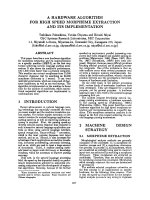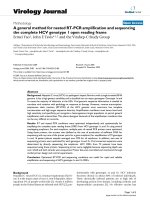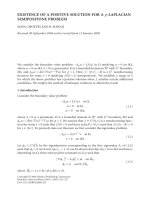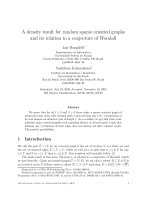A compact solution for ultra-light drone optical auto-detection and distance estimation using AI
Bạn đang xem bản rút gọn của tài liệu. Xem và tải ngay bản đầy đủ của tài liệu tại đây (743.17 KB, 11 trang )
Research
A compact solution for ultra-light drone
optical auto-detection and distance estimation using AI
Nguyen Ngoc Xuyen1, Phan Huy Anh2, Nguyen Le Cuong1*
1
Electric Power University, Hanoi, Vietnam.
Institute of Electronics, Academy of Military Science and Technology, Hanoi, Vietnam;
*
Corresponding author:
Received 26 Jul 2022; Revised 15 Sep 2022; Accepted 07 Nov 2022; Published 18 Nov 2022.
DOI: />2
ABSTRACT
This paper proposes a system for ultra-light drone (ULD) auto–detection using only one nonstatic optical PTZ camera. The system includes multi-stages of suspect objects detection,
clarification, and distance estimation. An AI model for detection and clarification stages is
designed based on the YOLOv3 architecture and trained with a practical dataset. In the
detection stage, the camera continuously pans, tilts, and zooms to take panoramic images of the
detection zone and pass them to the AI model. Once the AI model detects a suspect object, it will
switch to the verification stage. In this stage, the camera controlled by the AI model’s output
focuses on the target to clarify and estimate the distance to ULD. The proposed solution was
implemented and tested with popular fly cams. The results show that the system can auto-detect
ultra-light drones effectively with high accuracy.
Keywords: Ultra-Light Drones; Black Dot; YOLOv3 Model; Drone detection; Verification.
1. INTRODUCTION
The application of ultra-light drones (ULD) [5] has rapidly become popular in the last
few years. This type of vehicle is low cost, easy to assemble, and simple to use. Besides
providing many valuable utilities for users, ULD also has many negatives. The
uncontrolled use of ULDs may bring potential threats of using drones for terrorist attacks
and other illegal purposes. So that, solutions for detecting a ULD currently attract great
interest. There are many proposed methods of ULD detection and distance estimation,
such as radar, lidar, passive RF signal detection; acoustic signal detection; thermal and
optical image detection. The above methods all have their own advantages and
limitations. The way of using active radar may be limited or confusing due to ULD’s
small reflective size and echoes from undesired targets [2-5]; passive RF signal detection
cannot detect ULDs flying in automatic mode, without communication to the ground
control station [3, 5]; acoustic detection or lidar is not effective with small, low flight
speed aircraft [1-3]; Thermal image is costly and very close detection distance [2]; the
method of using optical images has acceptable detection range and can detect ULD with
high accuracy, but it can only be used in suitable light conditions [2, 3].
In recent years, AI in general, and image processing, in particular, have experienced
explosive development. The state-of-the-art image processing models are mainly divided
into two types: one-stage and two-stage [12]. Some typical one-stage models can be
mentioned as You Only Look Once (YOLO), Single Shot Display (SSD), and some
typical two-stage models can be listed as Fast Region-based Convolution Neural
Networks (Fast R-CNN), Faster R-CNN, Mask R-CNN. The above image processing
models are trained based on deep learning (DL) and use Convolution Neural Networks
(CNN) for object detection [10-12]. Some models have been applied in drone detection
Journal of Military Science and Technology, No.83, 11 - 2022
11
Electronics & Automation
applications, and their performance greatly supports the detection of drones from visible
data such as optical images, and thermal images. Studies in [1-4, 6-9, 12] indicated that
in drone detection applications, the YOLO model is widely used thanks to its balance
between accuracy and speed. The ULD detection systems using the optical image and AI
mentioned in [1-4, 6-9] can detect ULD with high accuracy, but there still exists some
issues limiting efficiency, such as short range [1, 2, 9]; high quality image requirement
[1, 2, 7-9]; inaccurate distance measurement [1]; restricted field of surveillance or
complicated system [3, 4]; not real-time detection [7-9].
In order to reduce the system complication as well as improve the efficiency of
detection and the precision of distance estimation using the optical images, in this paper,
the authors propose a solution that uses only one non-static PTZ optical camera with a
YOLO3-based AI model. The algorithm includes multi-stages of suspect objects
detection, clarification, and distance estimation. The AI model for detection and
clarification stages is designed based on the YOLOv3 architecture and trained with a
practical dataset. In the detection stage, the camera continuously pans, tilts, and zooms to
provide panoramic images of the zone of interest to the AI model. It is also controlled by
the AI model’s output to verify suspect objects. Once the AI model detects a suspect
object, it will switch to the verification stage. In this stage, the camera focuses on the
target to clarify and measure the distance. The proposed solution was implemented and
tested with popular fly cams. The results show that the system can detect ultra-light
drones effectively with high accuracy.
The above solution is researched and developed based on the theory of optics, image
processing, and camera controlling techniques. The rest of the paper is organized as
follows: Section 2 is about the methodology; Section 3 shows the experimental setup;
Section 4 illustrates results and section 5 concludes the paper.
2. METHODOLOGY
2.1. System architecture
Figure 1 below shows the architecture of the system to deploy the proposed solution.
In the figure, there are three big blocks which present for hardware devices and small
blocks present for processing blocks.
Figure 1. ULD detection system architecture.
The system’s hardware consists of a pan-tilt-zoom camera, a desktop computer, and a
desktop screen. The camera has 2 Megapixel sensor, 48 times optical zooming lens, a
12
N. N. Xuyen, P. H. Anh, N. L. Cuong, “A compact solution … and distance estimation using AI.”
Research
pan angle in the range of 0o to 360o, a tilt angle from -90o to 45o, and angle controlling
accuracy up to 0.1o/second. The desktop computer has an Nvidia GTX 2080Ti graphic
card, AMD Ryzen 9 CPU, and 16GB of RAM. The Ubuntu 18.04 LTS operation system,
OpenCV 4.2.0, Cuda Toolkit 10.2, and CuDNN 7.6.5 library are installed for the
application of image processing to detect ULD. The camera is connected to the computer
via a iga- thernet lin and transmits data via
stream protocol.
2.2. Algorithm
Figure 2. Software algorithm in detail.
The ULD detection and estimation system works in a 3-stage process as follows:
- Surveillance stage (the green dash line in figure 1): the PTZ camera turns
continuously to scan and look for trained objects. If the detected object is a black
dot, go on to stage 2. If the detected object is ULD, skip stage 2, go on to stage 3.
- Verification stage (the orange dash line in figure 1): the PTZ camera zooms and
focuses on black dots to verify whether they are ULD or not.
- Distance estimation stage (target locked – the blue dash line in figure 1): the system
estimates the distance to ULD and controls the PTZ camera to track the highest
confidence object.
Journal of Military Science and Technology, No.83, 11 - 2022
13
Electronics & Automation
The flowchart in figure 2 describes how the software algorithm works in detail.
Upon starting, the system is initialized by 3 parameters: monitoring ground distance,
monitoring height, and working mode. When operating, the camera is controlled
according to the installed parameters to capture images in the being monitored area. The
image processing model detects both ULD and black dots in parallel. At a long distance,
out of the effective range of the camera, the ULD may just be a black dot, and this makes
the AI model may not detect ULD correctly. Thus, all black dots are labeled as suspected
to be ULD objects, the camera will zoom in one by one in order of bigger to smaller
bounding box to confirm whether it is ULD or not. When a ULD object is detected, the
system will estimate the distance from the camera to the ULD. In case of many ULD
objects appear at the same time, the system has the ability to estimate the distance to all
of them. Detecting black dots and then clarifying them can help the detection system not
miss objects, thereby increasing the system’s performance and object detection distance.
2.3. Object detection with YOLOv3
YOLO is a one-stage image processing model based on a single CNN, it can predict
multiple bounding boxes in a single frame at the same time and calculate probabilities
for those boxes [6- 8]. It is extremely faster than two-stage image processing models
such as Mask R-CNN, Fast R-CNN, Faster R-CNN because this model skips the stage of
determining region proposals, the input image is taken to CNN directly for processing
[10-12]. Many versions of YOLO have been launched with improvements in the data
processing layers inside the model, processing rate, and accuracy. Among version 1,
version 2 and version 3 by Redmon, YOLO version 3 has the highest accuracy,
especially with small objects [12]. The architecture of YOLOv3 is shown in figure 3.
Figure 3. YOLOv3 network architecture [11, 12].
YOLOv3 model divides the input images into
square grid cells. Each grid cell
predicts the position information of bounding boxes, and calculates the probability of
each learning object, which the bounding box is corresponding to [11, 12]. The weight of
YOLOv3 has a total of 106 processing layers [12]. YOLOv3 uses an optimized sumsquare error loss function for bounding boxes prediction and binary cross-entropy loss
function for class prediction [10, 11]. This model predicts boxes at 3 different scales,
14
N. N. Xuyen, P. H. Anh, N. L. Cuong, “A compact solution … and distance estimation using AI.”
Research
with strides of 32, 16, 8 [11, 12]. It means that the resized input images are divided by
32, 16, and 8. The final output of YOLOv3 is a 3D-tensor that contains the coordinates,
width, height and object’s score of each bounding box in the processed image [11]. Due
to the highest accuracy, acceptable processing speed and ability to process large input
images, the YOLOv3 is suitable for ULD detection applications.
2.4. Distance estimation
A camera lens is made up of one or more converging lenses placed in series. The image
obtained from the camera is a real two-dimensional (2D) image. The distance from the
camera to the objects in the image can be computed based on the camera’s optical
parameters. Figure 4 shows how an object’s image is created in the camera’s sensor.
Figure 4. Distance estimation using optical parameters.
Distance to the object can be calculated by the following formula:
( )
( )
(
(
( )
( )
(
(
)
)
(1)
)
)
whereby:
he camera’s
taken from its specification;
The
can be calculated via the object’s size on the image.
In this paper, the object’s size on an image is the width of YOLOv3’s output
bounding boxes, which is the number of pixels of the ULD in the image;
: The
that was taken from the ULD library after clarification.
3. EXPERIMENTAL SETUP
3.1. Dataset
In this paper, we create our own practical dataset. The dataset includes 53736 images
of 2 common types of ULD: DJI Phantom 4 and DJI Mavic 2. Figure 5 shows example
images (cropped) of the dataset.
The images’ size is 1280 x 720 pixels, all captured by the
Z camera in many
different conditions of background, light, fog, distance to ULD, and camera’s focal
length. The dataset image quality is at various levels, from very small, and blurred to
clear images of ULD. The clear objects are labeled as drone, and the objects which are
not clear enough are labeled as dot, all in YOLO format. The dataset includes 10% of
background images without objects, 50% of ULD images, and 40% of black dot images.
Journal of Military Science and Technology, No.83, 11 - 2022
15
Electronics & Automation
Figure 5. Dataset example images.
3.2. Training model
When being trained, this dataset is split into two parts with a ratio: 90% is used for
training and 10% are used for validation. The YOLOv3 model is trained with the
Darknet-53 backbone. The training configurations are set following the Dar net’s
recommendation for custom object detection.
The best weight file is gotten at the step of 42000. The trained YOLOv3 model on our
custom dataset achieved 95.68% of (92.46% for black dot and 98.90% for
drones), 0.93 precision (thresh = 0.25), 0.96 of recall, 69.00% of IoU, loss value is
approximately 0.05 and image processing rate achieved 21.3 fps on the computer
mentioned above.
3.3. Field trial
The authors tested the detection system in a vacant land area that has straight line
vision over 500 meters to evaluate the effectiveness of the ULD detection method using
the optical camera and image processing techniques. The layout of the camera in the
monitoring area is illustrated in figure 6 and the actual ULD detection system is
illustrated in figure 7 below.
Figure 6. Camera layout in the monitoring area.
During the test, the camera’s pan angle is limited to the range of 0o to 90o; the image
resolution is 1280 x 720 pixels; the image rate is 20 fps; the camera’s zoom level and tilt angle
are tested in real conditions to find the optimal parameters for each distance and altitude.
16
N. N. Xuyen, P. H. Anh, N. L. Cuong, “A compact solution … and distance estimation using AI.”
Research
Figure 7. Actual ULD detection system.
The ULDs which are used for testing in this paper are DJI Phantom 4 and DJI Mavic
2. The width dimension (without propellers) of Phantom 4 and Mavic 2 is 350
millimeters and 275 millimeters respectively, their maximum cruise speed is 14 m/s in
ideal conditions. The tested altitude is 50 meters and 100 meters. Table 1 below shows
the camera’s configurations.
Table 1. System’s setting parameters.
Monitoring
Monitoring ground
Tilt angle
Zoom
altitude (meters)
distance (meters)
100
58.96O
10x
200
16.84O
15x
O
50 meters
300
10.51
25x
400
8.00O
30x
O
500
6.44
35x
O
100
47.65
10x
200
29.21O
15x
O
100 meters
300
19.49
25x
400
14.91O
30x
O
500
12.03
35x
4. RESULTS
4.1. Detection result
The authors performed 100 detection tests for each pair of altitude/ground distance
parameters. The detection performance is evaluated by 2 parameters:
(
) The
( ) and
is the percentage ratio of ULD true detection times and total tested times. The
is the relative distance error between estimating by the PTZ camera and measuring by
GPS. They are calculated as the following formulas:
(2)
Journal of Military Science and Technology, No.83, 11 - 2022
17
Electronics & Automation
|
|
(3)
whereby:
is true detection times
is the total tested times
is the distance to ULD measured by GPS
is the distance to ULD estimated by the camera.
Figures 8, 9, 10 below illustrate the detection results of the system.
Figure 8. Detection results of Phantom 4 and Mavic2
at the altitude of 50 meters and 100 meters.
Figure 9. Average measurement distance error of Phantom 4 and Mavic2
at the altitude of 50 meters and 100 meters.
18
N. N. Xuyen, P. H. Anh, N. L. Cuong, “A compact solution … and distance estimation using AI.”
Research
Figure 10. System found a dot (left) and then verify it is a drone (right).
4.2. Discussion
Tested results in figures 8, 9, 10 show that the detection system can detect and
clarify ULD objects effectively at a ground distance up to 500 meters, and altitude up
to 100 m. The system can detect 100% of drones appearing in the monitoring area at a
distance of 100 meters, an average of 98% of drones at a distance of 200 meters, 92%
at 300 meters, 79% at 400 meters, and 60% at 500 meters. At a further distance, the
decrease for all two kinds of drones. The
of DJI Phantom 4 decreases more quickly
than Mavic 2 because of its white color, this can make Phantom 4 easily mix in the
white clouds and become very hard to detect. Similar to Phantom 4, the Mavic 2
drones also can be mixed in dark clouds, but it is still easier to be detected due to the
black dot detection algorithm. Through the test, the authors recognize that both DJI
Mavic 2 and DJI Phantom 4 have detection precision at the altitude of 100 meters is
higher than detection precision at the altitude of 50 meters, because at a higher altitude,
4 arms of them are more clear to detect.
Going along with detection precision, the
is also higher at a further distance.
At 100 meters, the average
of both kinds of drones is less than 1% (0.56%), and it
raises more quickly at a further distance. The average
at 200 meters is 1.84%, at
300 meters is 4.49%, at 400 meters is 5.58% and at 500 meters is 7.76%. Similar to the
, the
of Mavic 2 is better than Phantom 4, and the results at the altitude of 100
meters are better than at the altitude of 50 meters.
Journal of Military Science and Technology, No.83, 11 - 2022
19
Electronics & Automation
The detection system in this paper also has several defects. The first defect is the
weakness of the camera when capturing images in bad light conditions. Both too bright
light and too dark light make the camera not work effectively although the camera has
infrared light to support capturing in night conditions. The second defect is that during
operation, the stage of compressing image data into RTSP stream causes a delay, which
makes the image being processed slower than the image captured by the camera. Since
distance estimation uses YOLOv3 output, a delay may lead to the miscalculation of
distance estimation due to the camera’s focal length and object size in the image is not
time-synchronized. The authors perform a test to measure the delay between the original
image (uncompressed into RTSP stream) and the image after being processed by
YOLOv3, the result shows that the total delay of image compression and image
processing is 0.5 seconds. Another critical factor affecting the system’s performance is
the camera’s vibration, and focusing speed while capturing at high zoom level. his can
ma e lose object’s traces due to the camera does not capture images timely, or object’s
image is not clear enough, as a result, the detection system ignores objects.
5. CONCLUSIONS
This paper proposes a system for ultra-light drones (ULD) auto-detection and distance
estimation using only one non-static optical PTZ camera. The YOLOv3 model, which is
trained with Darknet-53 backbone and custom dataset, achieves 95.68% of
(92.46% for black dot and 98.90% for drones), 0.93 of precision (thresh = 0.25), 0.96 of
recall, and 69.00% of IoU. The tested result shows that the detection system can detect
and clarify ULD objects effectively at the ground distance up to 500 m, altitude up to
100m, average detection precision achieves 100% at a distance of 100 m, 98% at a
distance of 200 m, and decrease down to 60% at 500 m. The average AMEE achieves
0.56% at 100 meters, 1.84% at 200 meters, and raise to 7.76% at 500 m. The detection
precision and the AMEE of DJI Mavic 2 are better than DJI Phantom 4, and the result at
the altitude of 100 meters is better than the results at 50 meters. Detecting black dots in
an image and then clarifying whether it is ULD or not helps the system increase
detection distance and efficiency of ULD detection. To improve the efficiency of object
detection and distance estimation, it is possible to upgrade the computer hardware,
camera to reduce vibration, image transmitting delay, however, this can increase the cost
of hardware.
REFERENCES
[1]. Y. C. Lai, Z. Y. Huang, “Detection of a Moving UAV Based on Deep Learning-Based
Distance Estimation,” Remote Sens. (2020). />[2]. F. Svanström, C. Englund and F. Alonso-Fernandez, "Real-Time Drone Detection and
Tracking with Visible, Thermal and Acoustic Sensors," 2020 25th International Conference
on
Pattern
Recognition
(ICPR),
pp.
7265-7272,
(2021),
doi:
10.1109/ICPR48806.2021.9413241.
[3]. E. Unlu, E. Zenou, N. Riviere, P. E. Dupouy, “Deep learning-based strategies for the
detection and tracking of drones using several cameras,” IPSJ T Comput Vis Appl 11, 7
(2019). />[4]. Igor S. Golyak, Dmitriy R. Anfimov, Iliya S. Golyak, Andrey N. Morozov, Anastasiya S.
Tabalina, and Igor L. Fufurin, “Methods for real-time optical location and tracking of
20
N. N. Xuyen, P. H. Anh, N. L. Cuong, “A compact solution … and distance estimation using AI.”
Research
unmanned aerial vehicles using digital neural networks,” Proc. SPIE 11394, Automatic
Target Recognition XXX, 113941B (2020); doi: 10.1117/12.2573209.
[5]. N. H. Hoang, N. L. Cuong, T. V. Kien, “Measuring the arrival time of signal to determine
coordinates of ultra-light drone,” Journal of Military Science and Technology, FEE (2020),
(in Vietnamese).
[6]. Seidaliyeva, Ulzhalgas & Akhmetov, Daryn & Ilipbayeva, Lyazzat & Matson, Eric., “RealTime and Accurate Drone Detection in a Video with a Static Background,” Sensors. 20.
3856. 10.3390/s20143856, (2020).
[7]. Y. Hu, X. Wu, G. Zheng and X. Liu, "Object Detection of UAV for Anti-UAV Based on
Improved YOLO v3," 2019 Chinese Control Conference (CCC), 2019, pp. 8386-8390,
(2019). doi: 10.23919/ChiCC.2019.8865525.
[8]. D. K. Behera and A. Bazil Raj, "Drone Detection and Classification using Deep Learning,"
2020 4th International Conference on Intelligent Computing and Control Systems (ICICCS),
pp. 1012-1016, (2020). doi: 10.1109/ICICCS48265.2020.9121150.
[9]. Hassan, Syed & Rahim, Tariq & Shin, Soo., “Real-time UAV Detection based on Deep
Learning Network,” 630-632. 10.1109/ICTC46691.2019.8939564, (2019).
[10]. J. Redmon, S. Divvala, R. Girshick, A. Farhadi, “You Only Look Once: Unified, Real-Time
Object Detection,” arXiv:1506.02640v5 [cs.CV], (2016).
[11]. Joseph Redmon, Ali Farhadi, “YOLOv3: An Incremental Improvement,” arXiv:
1804.02767v1 [cs.CV], (2018).
[12]. S.V. Viraktamath, M. Yavagal, R. Byahatti, “Object Detection and Classification using
YOLOv3”, International Journal of Engineering Research & Technology, Vol. 10, Issue 02,
(2021).
TÓM TẮT
Giải pháp tinh gọn để tự động phát hiện và ước lượng khoảng cách đến
máy bay không người lái siêu nhẹ sử dụng ảnh quang học và trí tuệ nhân tạo
Bài báo này đề xuất một giải pháp tự động phát hiện máy bay không người lái
siêu nhẹ (flycam) sử dụng duy nhất một camera PTZ động. Hệ thống phát hiện
flycam theo một quy trình ba bước: phát hiện chấm đen, làm rõ chấm đen có phải
flycam khơng và ước lượng khoảng cách đến flycam. Việc phát hiện và làm rõ
chấm đen được thực hiện bởi một mơ hình trí tuệ nhân tạo dựa trên kiến trúc của
YOLOv3, được huấn luyện với tập dữ liệu về flycam do nhóm tác giả xây dựng. Ở
bước phát hiện chấm đen, camera PTZ liên tục quay và chụp lại hình ảnh của khu
vực cần giám sát rồi chuyển hình ảnh tới mơ hình trí tuệ nhân tạo để xử lý. Khi
phát hiện có chấm đen, hệ thống sẽ thực hiện làm rõ chấm đen đó có phải flycam
hay khơng, nếu đúng, hệ thống sẽ bám theo đối tượng, đồng thời ước lượng khoảng
cách đến đối tượng. Giải pháp trên được nghiên cứu và thử nghiệm với các loại
flycam thông dụng. Kết quả cho thấy, hệ thống có thể tự động phát hiện flycam với
độ chính xác cao ở khoảng cách lên đến 500 mét.
Từ khố: Máy bay hơng người lái siêu nhẹ; hát hiện chấm đen; hát hiện flycam; Mơ hình YOLOv3; Làm rõ đối
tượng.
Journal of Military Science and Technology, No.83, 11 - 2022
21









